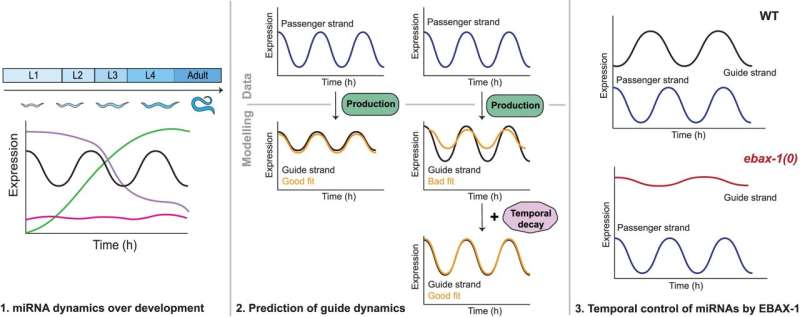Largest study of developmental microRNA dynamics uncovers mechanism of their regulation

Gene expression is controlled by numerous small RNA molecules called microRNAs, or miRNAs. However, specific functions of most miRNAs remain poorly understood. Working with worms, Friedrich Miescher Institute (FMI) researchers created an encyclopedia of miRNA dynamics during development, uncovering mechanisms of their regulation.
The , published in Nucleic Acids Research, help us better understand typical development and may reveal how these tiny molecules contribute to disease when they become dysfunctional.
By binding and silencing specific RNA molecules that code for proteins, miRNAs regulate gene expression. Scientists have known that the controlled accumulation of miRNAs influences their function in many developmental processes, but the expression patterns of these small RNA molecules during development remain mysterious.
To address this question, researchers in the Grosshans lab profiled the expression of more than 150 miRNAs as C. elegans larvae developed into adult worms. "The first surprise for us was how many dynamic behaviors we saw for different miRNAs," Grosshans says.
"By knowing when some of these miRNAs are most abundant in the worms, we can start to make predictions on the developmental processes they control and then explore these processes."
Next, the team used mathematical modeling to probe mechanisms that could explain the observed miRNAs expression patterns. For one miRNA, called miR-235, the model predicted that a combination of rhythmic production and decay leads to the formation of dynamic expression patterns. Experiments confirmed this prediction and identified a protein that is essential to degrade miR-235.
This miRNA is conserved from worms to insects to mammals: In flies, it regulates the cycles of alertness and sleepiness; in humans, it is involved in oncogenesis—the process through which healthy cells transform into cancer cells.
Previous studies have shown that, in other species, miR-235 has also an oscillatory expression pattern. "It's intriguing to see that, although we focused on C. elegans, some general dynamics seem to be maintained in other organisms," Grosshans says. "It supports the idea that when we think about conservation, we should not stop at the molecules but also consider their dynamic patterns of expression and regulation."
More information: Smita Nahar et al, Dynamics of miRNA accumulation during C. elegans larval development, Nucleic Acids Research (2024).



















